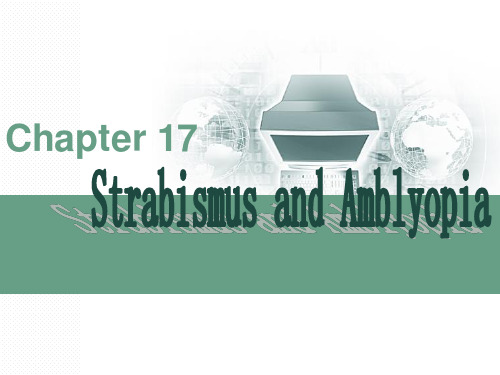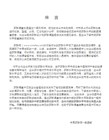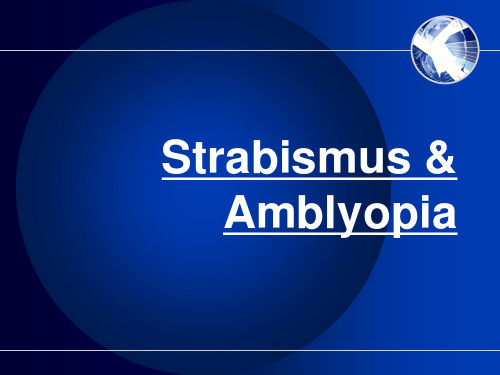斜视与屈光不正 英文课件
合集下载
视光学和斜视弱视介绍课件

文档仅供参考,不能作为科学依据,请勿模仿;如有不当之处,请联系网站或本人删除。
远视眼的机理
在调节静止情况下,平行光线经过眼球屈光系统, 形成的焦点位于视网膜的后面,这种屈光状态称 为远视眼。
文档仅供参考,不能作为科学依据,请勿模仿;如有不当之处,请联系网站或本人删除。
远视眼机理
文档仅供参考,不能作为科学依据,请勿模仿;如有不当之处,请联系网站或本人删除。
文档仅供参考,不能作为科学依据,请勿模仿;如有不当之处,请联系网站或本人删除。
2.PRK手术
准分子激光角膜切削术(photorefractive keratectomy, PRK) 适应症:近视小于-8.00 散光小于-2.00 缺点: 预测性差、回退角膜浑浊。
文档仅供参考,不能作为科学依据,请勿模仿;如有不当之处,请联系网站或本人删除。
屈光检查方法(1)
主观检查法 :又称为显然验光法,插片法。适应 症:40岁以上的患者。
第二云雾法,适应症:远视或远视散光患者,高 度远视镜片,逐渐降低远视的度数,直至最佳视 力。
文档仅供参考,不能作为科学依据,请勿模仿;如有不当之处,请联系网站或本人删除。
屈光检查法(2)
客观检查法 :睫状肌麻痹,客观准确 适应症:年幼儿童 具体方法: 检影法 电脑验光仪。
文档仅供参考,不能作为科学依据,请勿模仿;如有不当之处,请联系网站或本人删除。
主要内容
▪ 视光学 visual optics ▪ 斜视 strabismus ▪ 儿童弱视 amblyopia
视光学visual optics
文档仅供参考,不能作为科学依据,请勿模仿;如有不当之处,请联系网站或本人删除。
SIK手术
准分子激光原位角膜磨镶术(excimer laser in situ keratomileusis,LASIK)
屈光不正、斜视和弱视眼科学课件PPT课件

正视、屈光不正与老视
一、婴幼儿的屈光状态和发育 正常情况下,婴幼儿出生不久都处于远视状态,随着 生长发育,逐渐趋于正视,至学龄前基本达到正视, 该过程称为“正视化” 二、正视(emmetropia) 眼调节静止时外界的平行光线经眼的屈光系统后,恰 好在视网膜黄斑中心凹聚焦。正视眼的远点为无限远。
三、非正视眼(屈光不正
散光矫治:散光应以柱镜片矫正,不规 则散光可试用硬性角膜接触镜矫正。
六、屈光参差 概念:双眼屈光状态不等,不论是屈光不正 的性质或度数的不同均称为屈光参差。度数相差 2.50D以上通常会因融像困难而出现症状。 临床表现:轻者无症状 视疲劳 交替 视力 斜视或弱视 矫正 充分矫正 接触镜:双眼屈光参差过大
临床表现:
视力 视疲劳 眼位偏斜 (内
斜视) 眼球的变化 假性近视 诊断 注意假性近视:睫状肌麻痹剂 矫正: 凸透镜
THANK
YOU
SUCCESS
2019/4/21
与远视有关的几个常见问题 1. 屈光性弱视 一般发生在高度远视且在6岁前 未给予适当矫正的儿童,通过检查及早 发现并完全矫正,同时行适当的弱视训 练可以达到良好的治疗效果。 2. 内斜 远视者未进行屈光矫正,在远 距工作时就开始使用调节,近距工作时 使用更多的调节,产生内隐斜或内斜。 如果内斜持续存在,就会出现斜视性弱 视。
近视的病因: 内因与外因
临床表现:远视力减退、视疲劳、 眼位偏 斜(外斜视)、眼球突出 高度近视眼底改变:弧形斑、豹纹眼底、 黄斑改变(出血或视网膜下新生血管膜)、 巩膜后葡萄肿 病理性近视
并发症:晶状体混浊;玻璃体液化、混浊 和后脱离;视网膜裂孔;视网膜脱离
眼底改变(豹纹状眼底、弧形斑等)
矫正:
屈光不正矫治 Correction of refraction
眼科学课件:斜视与弱视

斜视角的单位 圆周度 三棱镜度数(prism diopter,PD)
Nine positions
2 version
3
232ຫໍສະໝຸດ 1231: primary position 2: secondary position 3: tertitary position
2
3
Diagnostic positions
Worth four-dot test Bagolini Striated Glass Test
2.4 Sensory Function Test(2)
2 Fusion Potential (融合储备力检查)
prism
Red filter
light
2.4 Sensory Function Test
Superior oblique mucle— Trochlear Nerve(Ⅳ)
Medial,Inferior and Superior Rectus Muscles and the Inferior Oblique Muscle— Oculomotor Nerve(Ⅲ)
Functions of the Ocular Mucles
3
2
3
2
1
2
3
2
3
1:第一眼位(primary position)
2:第二眼位 (secondary position) 3:第三眼位(tertitary position)
诊断眼位
Normal and Abnormal Binocular Eye Movement
Ductions and Binocular Eye Movement
2.3 Eye Movement Examination Parks 3 test
Nine positions
2 version
3
232ຫໍສະໝຸດ 1231: primary position 2: secondary position 3: tertitary position
2
3
Diagnostic positions
Worth four-dot test Bagolini Striated Glass Test
2.4 Sensory Function Test(2)
2 Fusion Potential (融合储备力检查)
prism
Red filter
light
2.4 Sensory Function Test
Superior oblique mucle— Trochlear Nerve(Ⅳ)
Medial,Inferior and Superior Rectus Muscles and the Inferior Oblique Muscle— Oculomotor Nerve(Ⅲ)
Functions of the Ocular Mucles
3
2
3
2
1
2
3
2
3
1:第一眼位(primary position)
2:第二眼位 (secondary position) 3:第三眼位(tertitary position)
诊断眼位
Normal and Abnormal Binocular Eye Movement
Ductions and Binocular Eye Movement
2.3 Eye Movement Examination Parks 3 test
斜视与屈光不正英文课件-医学-

Definitions
Secondary deviation: The deviation measured with the paretic eye f i x i n g and the normal eye deviating.
Torsion: Rotation of the eye about i t s anteroposterior axis
Eccentric Fixation
In eyes with sufficiently severe amblyopia, an extrafoveal retinal area may be used for fixation under monocular viewing conditions. It is always associated with severe amblyopia and unstable fixation. Gross eccentric fixation can be readily identified clinically by occluding the dominant eye and directing the patient’s attention to a light source held directly in front. An eye with gross eccentric fixation
Sensory fusion and stereopsis are the two different physiologic processes that are responsible for binocular vision.
Sensory Aspects
Physiology
Sensory Fusion & Stereopsis
英文课件斜视与屈光不正ppt

Physiology
Motor Aspects
Yoke Muscles: The pair of agonist muscles with the same primary action.
Physiology
Sensory Aspects
Binocular Vision: Objects imaged on the two foveas.
Definitions
Orthophoria: The absence of any tendency of either eye to deviate when fusion is suspended. Seldom Primary deviation: The deviation measured with the normal eye fixing and the eye with the paretic muscle deviating. Prism diopter: A unit of angular measurement used to characterize ocular deviation. A 1-diopter prism deflects a ray of light toward the base of the prism by 1 centimeter at 1 meter. One degree of arc equals approximately 1.7∆.
Definitions
Secondary deviation: The deviation measured with the paretic eye fixing and the normal eye deviating.
眼的屈光ppt课件

1.视力—远、近视力均差
2.视疲劳
a.头痛、眼胀、流泪、恶心、呕吐
b.眯眼—达到针孔效果,远近都用
c.幼年时期高度散光,易致弱视
3.眼底
a.视盘呈垂直椭圆形,边缘模糊
b.检眼镜不能很清晰地看清眼底
46
五.散 光
㈣矫正
• 规则散光—散瞳验光 配戴合适散光镜片 配足散光度数 较佳矫正效果
• 不规则散光—角膜接触镜
适应:薄角膜患者手术。LASIK手术的补充
33
四.近 视
㈢分类:
2.屈光性近视 a.曲率性近视—眼轴正常,屈光力强
角膜和晶体曲度大,屈光力增强 调节痉挛、圆锥角膜、球形晶体
b.指数性近视—晶体屈光指数
34
四.近 视
㈣临床表现
1.视力—远视力下降、近视力正常 2.视疲劳和外斜视
• 近距离阅读,不调节,集合过度 • 调节与集合平衡失调,易视疲劳 • 时间长后,易致外隐斜和外斜视
27
三.远 视
㈤矫正
• 散瞳验光 • 配镜矫正
配戴足量 凸透镜片
28
四、近 视
(Myopia)
29
四.近 视
㈠概念
不用调节时,平行光线经过眼屈光系 统的屈折,聚焦在视网膜前面。
30
四.近 视
㈡病因:
1.遗传:
高 度—常染色体隐性 中低度—多基因
2.发育:
婴幼儿时—眼球小,为生理性远视 发育过度—眼轴过长,后天性近视
㈣临床表现
3.内斜视:
学龄前儿童高度远视 可因为调节与集合过强 诱发内斜视而造成弱视
(调节性内斜视)
4.眼底:
视盘小、色红、边界模糊
视盘会变小
26
视光学与斜视弱视介绍课件

现,训练中心窝,提高中心窝功能,消除旁中心注。 反传统遮盖法 与后像法结合,遮盖弱视眼。
辅助疗法
视觉刺激疗法 CAM疗法 精细作业训练 红色滤光片法 刺激黄斑中心窝,提高中心窝的功
能 红光闪烁法原理与红色滤光片法
注意事项
遮盖性弱视: 年幼:3岁之内 遮盖时间:过长,没有及时复诊,或医源性遮盖
麻痹性斜视
病因: 先天发育异常、产伤 后天性 外伤、炎症、脑血管病变、脑
肿瘤、代谢病(糖尿病)
临床表现
复视和混淆视 眼球运动受限 斜视 各个方向斜视角不等。第二斜视角大于第一
斜视角。 代偿头位
治疗 方法
病因治疗 神经科、耳鼻喉科、内科会诊, 针对病因治疗。
光学治疗 三棱镜:≤10∆ 手术:斜视稳定半年之后
屈光检查方法(1)
主观检查法 :又称为显然验光法,插片法。适应 症:40岁以上的患者。
第二云雾法,适应症:远视或远视散光患者,高 度远视镜片,逐渐降低远视的度数,直至最佳视 力。
屈光检查法(2)
客观检查法 :睫状肌麻痹,客观准确 适应症:年幼儿童 具体方法: 检影法 电脑验光仪。
治疗原则
b.眼外肌正常;
c.各方向斜视角相等;
d.左、右注视斜角相等。
分类:内斜、外斜、性垂直斜
视少见。
共同性内斜视
调节性内斜视: a.2-5岁发病; b.中度远视 c.早期为间歇性 d. AC/A正常。
共同性内斜视 comitant esotropia
非调节性内斜视:与屈光调节没有关系 后者包括:先天性内斜视 基本型内斜 视 近距离内斜视
共同性内斜视的诊断:
眼位 :内斜视 发病年龄:2-4岁 屈光不正: 中、高度远视 眼球运动:正常 左右眼注视斜视角相等 各个方向斜视角相等
辅助疗法
视觉刺激疗法 CAM疗法 精细作业训练 红色滤光片法 刺激黄斑中心窝,提高中心窝的功
能 红光闪烁法原理与红色滤光片法
注意事项
遮盖性弱视: 年幼:3岁之内 遮盖时间:过长,没有及时复诊,或医源性遮盖
麻痹性斜视
病因: 先天发育异常、产伤 后天性 外伤、炎症、脑血管病变、脑
肿瘤、代谢病(糖尿病)
临床表现
复视和混淆视 眼球运动受限 斜视 各个方向斜视角不等。第二斜视角大于第一
斜视角。 代偿头位
治疗 方法
病因治疗 神经科、耳鼻喉科、内科会诊, 针对病因治疗。
光学治疗 三棱镜:≤10∆ 手术:斜视稳定半年之后
屈光检查方法(1)
主观检查法 :又称为显然验光法,插片法。适应 症:40岁以上的患者。
第二云雾法,适应症:远视或远视散光患者,高 度远视镜片,逐渐降低远视的度数,直至最佳视 力。
屈光检查法(2)
客观检查法 :睫状肌麻痹,客观准确 适应症:年幼儿童 具体方法: 检影法 电脑验光仪。
治疗原则
b.眼外肌正常;
c.各方向斜视角相等;
d.左、右注视斜角相等。
分类:内斜、外斜、性垂直斜
视少见。
共同性内斜视
调节性内斜视: a.2-5岁发病; b.中度远视 c.早期为间歇性 d. AC/A正常。
共同性内斜视 comitant esotropia
非调节性内斜视:与屈光调节没有关系 后者包括:先天性内斜视 基本型内斜 视 近距离内斜视
共同性内斜视的诊断:
眼位 :内斜视 发病年龄:2-4岁 屈光不正: 中、高度远视 眼球运动:正常 左右眼注视斜视角相等 各个方向斜视角相等
(精品) 斜视和弱视(英文版)课件

❖Correction of refractive error ❖Train ❖surgery
hyperphoria上隐斜
❖Tendency for one eye to deviate upward ❖Easy to tire
hyperphoria上隐斜
❖ prism ❖Surgery >10∆
extraocular muscles function
❖medial rectus 内直肌: adduction 内转
❖Laterior rectus 上直肌: elevation上转 adduction,intorsion内转内旋
❖History ❖General eye examination ❖Visual acuity ❖Determination of refractive error ❖Determination of angle of strbismus
Determination of angle of strbismus斜 视的定性和定量检查
❖ 20%~25% among esotropia
(1) Sufficiently high hyperopia,requiring so much accommodation (therefore convergence)
(2) high AC/A
Accommodative esotropia (due to hyperopia )
Strabismus & Amblyopia
case
5y, Female ,right eye strabismus afer 1 y
general eye examination (-) , VA(distance): OD: 4.3(0.2) OS: 4.9(0.8) corneal light reflection(near and distance):
hyperphoria上隐斜
❖Tendency for one eye to deviate upward ❖Easy to tire
hyperphoria上隐斜
❖ prism ❖Surgery >10∆
extraocular muscles function
❖medial rectus 内直肌: adduction 内转
❖Laterior rectus 上直肌: elevation上转 adduction,intorsion内转内旋
❖History ❖General eye examination ❖Visual acuity ❖Determination of refractive error ❖Determination of angle of strbismus
Determination of angle of strbismus斜 视的定性和定量检查
❖ 20%~25% among esotropia
(1) Sufficiently high hyperopia,requiring so much accommodation (therefore convergence)
(2) high AC/A
Accommodative esotropia (due to hyperopia )
Strabismus & Amblyopia
case
5y, Female ,right eye strabismus afer 1 y
general eye examination (-) , VA(distance): OD: 4.3(0.2) OS: 4.9(0.8) corneal light reflection(near and distance):
屈光不正近视远视散光ppt课件

概念:当调节放松时,平行光线经过眼的屈光系统后聚焦在视网膜之后。
特点: 视远不清 视近更不清 始终需要调节
远视分类:
按屈光成分: 轴性远视 屈光性远视 低度远视 < +3D 按远视程度分:中度远视 +3D~+5D 高度远视 > +5D
远视治疗:
框架眼镜 角膜接触镜 准分子手术:适于成人稳定性远视
1.轻度远视:如无症状则不需矫正。 2.中度远视:应戴镜矫正视力,消除视疲劳 及防止内斜视发生。 3.儿童远视:有减轻趋势,应每年检查一 次,随时调整度数,以防过矫。 4.成人远视:若有内隐斜则全矫正,若有较 大度数外隐斜则低矫正。
概念:双眼屈光度数不等 临床表现 1.轻度屈光参差可无症状。 2.屈光参差超过2.50D时,因融像困难而破坏双眼单视,出现视疲劳和双眼视力降低。(每0.25D的差异产生0.5%的像差,5%范围以内的像差能被主觉上接受) 3.交替视力 4.弱视或斜视。
屈光参差治疗:
框架眼镜 角膜接触镜 屈光手术
老视(prebyopia):
定 义:由于年龄增长所致的生理性调节力减弱。 老视≠远视 一般规律:45岁左右+1.50D; 50岁左右+2.00D; 60岁左右+3.00D。 远视“早花”,近视晚花或不花。 矫正方法:老花镜(凸透镜) 人工晶体植入
专家观点:
知识点回顾:
1.掌握屈光不正的临床表现及治疗。 2.熟悉调节与屈光不正的关系。 3.熟悉调节与年龄的关系。 4.了解如何有效预防近视。
屈光: 光线经过光学界面后改变行进方向 的现象。 屈光力:光线在界面的偏折程度。 单位为屈光度.D=1/f(f:焦距) 晶状体19D 角膜43D 3/4 屈光状态:指人眼对于外界物体的成像特性 或情况。
特点: 视远不清 视近更不清 始终需要调节
远视分类:
按屈光成分: 轴性远视 屈光性远视 低度远视 < +3D 按远视程度分:中度远视 +3D~+5D 高度远视 > +5D
远视治疗:
框架眼镜 角膜接触镜 准分子手术:适于成人稳定性远视
1.轻度远视:如无症状则不需矫正。 2.中度远视:应戴镜矫正视力,消除视疲劳 及防止内斜视发生。 3.儿童远视:有减轻趋势,应每年检查一 次,随时调整度数,以防过矫。 4.成人远视:若有内隐斜则全矫正,若有较 大度数外隐斜则低矫正。
概念:双眼屈光度数不等 临床表现 1.轻度屈光参差可无症状。 2.屈光参差超过2.50D时,因融像困难而破坏双眼单视,出现视疲劳和双眼视力降低。(每0.25D的差异产生0.5%的像差,5%范围以内的像差能被主觉上接受) 3.交替视力 4.弱视或斜视。
屈光参差治疗:
框架眼镜 角膜接触镜 屈光手术
老视(prebyopia):
定 义:由于年龄增长所致的生理性调节力减弱。 老视≠远视 一般规律:45岁左右+1.50D; 50岁左右+2.00D; 60岁左右+3.00D。 远视“早花”,近视晚花或不花。 矫正方法:老花镜(凸透镜) 人工晶体植入
专家观点:
知识点回顾:
1.掌握屈光不正的临床表现及治疗。 2.熟悉调节与屈光不正的关系。 3.熟悉调节与年龄的关系。 4.了解如何有效预防近视。
屈光: 光线经过光学界面后改变行进方向 的现象。 屈光力:光线在界面的偏折程度。 单位为屈光度.D=1/f(f:焦距) 晶状体19D 角膜43D 3/4 屈光状态:指人眼对于外界物体的成像特性 或情况。
斜视和弱视(英文版)课件

❖History ❖General eye examination ❖Visual acuity ❖Determination of refractive error ❖Determination of angle of strbismus
Determination of angle of strbismus斜 視的定性和定量檢查
50Δeso,the angle of deviation is the same in all directions of gaze,usually left eye fixation ,right eye deviation full cycloplegic refaction
OD: +2.50DS+0.50X090----4.4 OS: +1.50DS+0.25X090----5.0
Strabismus & Amblyopia
case
5y, Female ,right eye strabismus afer 1 y
general eye examination (-) , VA(distance): OD: 4.3(0.2) OS: 4.9(0.8) corneal light reflection(near and distance):
❖Eccentric fixation 偏心 注視
❖Amblyopia 弱視
Strabismus 斜視
❖ Deviation from perfect ocualr alignment 斜視指的是兩眼向前注視 時,兩只眼位不平行,有 一只眼向內斜(內斜視) 或向外斜(外斜視),或向 上(上斜)。
Examination
Esophoria 內隱斜
Determination of angle of strbismus斜 視的定性和定量檢查
50Δeso,the angle of deviation is the same in all directions of gaze,usually left eye fixation ,right eye deviation full cycloplegic refaction
OD: +2.50DS+0.50X090----4.4 OS: +1.50DS+0.25X090----5.0
Strabismus & Amblyopia
case
5y, Female ,right eye strabismus afer 1 y
general eye examination (-) , VA(distance): OD: 4.3(0.2) OS: 4.9(0.8) corneal light reflection(near and distance):
❖Eccentric fixation 偏心 注視
❖Amblyopia 弱視
Strabismus 斜視
❖ Deviation from perfect ocualr alignment 斜視指的是兩眼向前注視 時,兩只眼位不平行,有 一只眼向內斜(內斜視) 或向外斜(外斜視),或向 上(上斜)。
Examination
Esophoria 內隱斜
- 1、下载文档前请自行甄别文档内容的完整性,平台不提供额外的编辑、内容补充、找答案等附加服务。
- 2、"仅部分预览"的文档,不可在线预览部分如存在完整性等问题,可反馈申请退款(可完整预览的文档不适用该条件!)。
- 3、如文档侵犯您的权益,请联系客服反馈,我们会尽快为您处理(人工客服工作时间:9:00-18:30)。
Chapter 15
Strabismus
Fujian Provincial Hospital
Wenjie Wu MD., PhD.
Any Deviation From Perfect Ocular Alignment
Definitions
Conjugate movement: Movement of the eyes in the same direction at the same time. Ductions: Monocular rotations with no consideration of the position of the other eye.
Physiology
Sensory fusion is the process whereby dissimilarities between the two images are not appreciated. IN the process of fusion, the direction values of these points can be modified. Fusion is possible because subtle differences between the two images are ignored, and stereopsis, or binocular depth perception, occurs because of the cerebral integration of these two slightly dissimilar images.
Sensory fusion and stereopsis are the two different physiologic processes that are responsible for binocular vision.
Sensory Aspects
Sensory Fusion & Stereopsis
Physiology
Motor Aspects
Yoke Muscles: The pair of agonist muscles with the same primary action.
Physiology
Sensory Aspects
Binocular Vision: Objects imaged on the two foveas.
Sensory Aspects
Anomalous Retinal Correspondence
Physiology
Anomalous retinal correspondence is a sensory adaptation that occurs in strabismus under binocular viewing conditions. Heterotropia leads to suppression in the non-fixating eye and a shift in the visual direction of the deviated eye. This shift in visual direction offsets the amount of motor deviation and prevents the perception of diplopia. Stereopsis remains abnormal. Eccentric Fixation In eyes with sufficiently severe amblyopia, an extrafoveal retinal area may be used for fixation under monocular viewing conditions. It is always associated with severe amblyopia and unstable fixation. Gross eccentric fixation can be readily identified clinically by occluding the dominant eye and directing the patient’s attention to a light source held directly in front. An eye with gross eccentric fixation will not point toward the light source but will appear detected by an ophthalmoscope that projects a small fixation target onto the retina.
Because of the different vantage point in space of each eye (For one object only), the image in each eye is actually slightly different from that in the other.
Sensory Aspects
Physiology
SuppressionБайду номын сангаас
Under binocular viewing conditions, the images seen by one eye become predominant and those seen by the other eye are not perceived (suppression). Suppression takes the form of a scotoma in the deviating eye only under binocular viewings.
Heterotropia (Tropia) Strabismus: Manifest deviation of the eyes that cannot be controlled by binocular fusion. Esotropia Exotropia Hypertropia Hypotropia
Amblyopia Prolonged abnormal visual experience in a child under the age of 7 years may lead to amblyopia (reduced visual acuity in the absence of detectable organic disease in one eye). Anomalous Retinal Correspondence
Physiology
Motor Aspects
Individual Muscle Function
Physiology
Motor Aspects
Field of Action
Physiology
Motor Aspects
Synergistic & Antagonistic Muscles Synergistic muscles are those that those that have the same field of action. Muscles synergistic for one function may be antagonistic for anther.
Definitions
Orthophoria: The absence of any tendency of either eye to deviate when fusion is suspended. Seldom Primary deviation: The deviation measured with the normal eye fixing and the eye with the paretic muscle deviating. Prism diopter: A unit of angular measurement used to characterize ocular deviation. A 1-diopter prism deflects a ray of light toward the base of the prism by 1 centimeter at 1 meter. One degree of arc equals approximately 1.7∆.
Sensory Aspects
Sensory Changes in Strabismus
Physiology
Up to age 7 or 8, the brain usually develops responses to abnormal binocular vision that may not occur if the onset of strabismus in later. Diplopia The foveal image is localized straight ahead, while the peripheral image of the same object in the other eye is localized in some other direction. Thus, the same object is seen in two places (diplopia) Suppression Amblyopia Anomalous Retinal Correspondence
Definitions
Heterophoria(phoria): Latent deviation of the eyes held straight by binocular fusion. Esophoria Exophoria Hyperphoria
Strabismus
Fujian Provincial Hospital
Wenjie Wu MD., PhD.
Any Deviation From Perfect Ocular Alignment
Definitions
Conjugate movement: Movement of the eyes in the same direction at the same time. Ductions: Monocular rotations with no consideration of the position of the other eye.
Physiology
Sensory fusion is the process whereby dissimilarities between the two images are not appreciated. IN the process of fusion, the direction values of these points can be modified. Fusion is possible because subtle differences between the two images are ignored, and stereopsis, or binocular depth perception, occurs because of the cerebral integration of these two slightly dissimilar images.
Sensory fusion and stereopsis are the two different physiologic processes that are responsible for binocular vision.
Sensory Aspects
Sensory Fusion & Stereopsis
Physiology
Motor Aspects
Yoke Muscles: The pair of agonist muscles with the same primary action.
Physiology
Sensory Aspects
Binocular Vision: Objects imaged on the two foveas.
Sensory Aspects
Anomalous Retinal Correspondence
Physiology
Anomalous retinal correspondence is a sensory adaptation that occurs in strabismus under binocular viewing conditions. Heterotropia leads to suppression in the non-fixating eye and a shift in the visual direction of the deviated eye. This shift in visual direction offsets the amount of motor deviation and prevents the perception of diplopia. Stereopsis remains abnormal. Eccentric Fixation In eyes with sufficiently severe amblyopia, an extrafoveal retinal area may be used for fixation under monocular viewing conditions. It is always associated with severe amblyopia and unstable fixation. Gross eccentric fixation can be readily identified clinically by occluding the dominant eye and directing the patient’s attention to a light source held directly in front. An eye with gross eccentric fixation will not point toward the light source but will appear detected by an ophthalmoscope that projects a small fixation target onto the retina.
Because of the different vantage point in space of each eye (For one object only), the image in each eye is actually slightly different from that in the other.
Sensory Aspects
Physiology
SuppressionБайду номын сангаас
Under binocular viewing conditions, the images seen by one eye become predominant and those seen by the other eye are not perceived (suppression). Suppression takes the form of a scotoma in the deviating eye only under binocular viewings.
Heterotropia (Tropia) Strabismus: Manifest deviation of the eyes that cannot be controlled by binocular fusion. Esotropia Exotropia Hypertropia Hypotropia
Amblyopia Prolonged abnormal visual experience in a child under the age of 7 years may lead to amblyopia (reduced visual acuity in the absence of detectable organic disease in one eye). Anomalous Retinal Correspondence
Physiology
Motor Aspects
Individual Muscle Function
Physiology
Motor Aspects
Field of Action
Physiology
Motor Aspects
Synergistic & Antagonistic Muscles Synergistic muscles are those that those that have the same field of action. Muscles synergistic for one function may be antagonistic for anther.
Definitions
Orthophoria: The absence of any tendency of either eye to deviate when fusion is suspended. Seldom Primary deviation: The deviation measured with the normal eye fixing and the eye with the paretic muscle deviating. Prism diopter: A unit of angular measurement used to characterize ocular deviation. A 1-diopter prism deflects a ray of light toward the base of the prism by 1 centimeter at 1 meter. One degree of arc equals approximately 1.7∆.
Sensory Aspects
Sensory Changes in Strabismus
Physiology
Up to age 7 or 8, the brain usually develops responses to abnormal binocular vision that may not occur if the onset of strabismus in later. Diplopia The foveal image is localized straight ahead, while the peripheral image of the same object in the other eye is localized in some other direction. Thus, the same object is seen in two places (diplopia) Suppression Amblyopia Anomalous Retinal Correspondence
Definitions
Heterophoria(phoria): Latent deviation of the eyes held straight by binocular fusion. Esophoria Exophoria Hyperphoria
